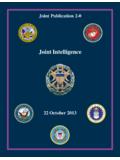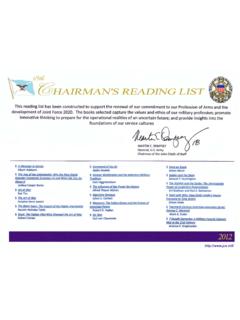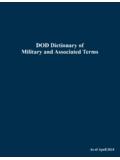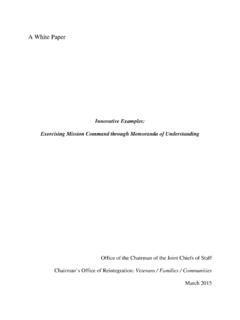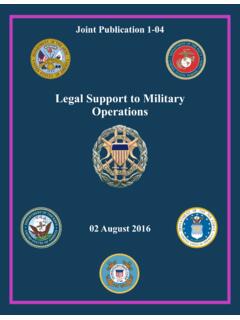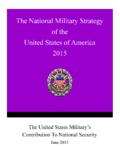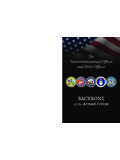Transcription of JP 3-41, Chemical, Biological, Radiological, and Nuclear ...
1 DEPAOTMENTFTHEARMY EUNITEDSTATSOAFAMERICRTHISWE'LLDEFENDJ oint Publication 3-41 Chemical, Biological, Radiological, and Nuclear Response09 September 2016i PREFACE 1. Scope This publication provides joint doctrine for military domestic or international response to minimize the effects of a chemical, biological, radiological, or Nuclear incident. 2. Purpose This publication has been prepared under the direction of the Chairman of the joint Chiefs of Staff (CJCS). It sets forth joint doctrine to govern the activities and performance of the Armed Forces of the United States in operations, and it provides considerations for military interaction with governmental and nongovernmental agencies, multinational forces, and other interorganizational partners. It provides military guidance for the exercise of authority by combatant commanders and other joint force commanders (JFCs) and prescribes joint doctrine for operations and training.
2 It provides military guidance for use by the Armed Forces in preparing and executing their plans and orders. It is not the intent of this publication to restrict the authority of the JFC from organizing the force and executing the mission in a manner the JFC deems most appropriate to ensure unity of effort in the accomplishment of objectives. 3. Application a. joint doctrine established in this publication applies to the joint Staff, commanders of combatant commands, subunified commands, joint task forces, subordinate components of these commands, the Services, combat support agencies, and the National Guard. b. The guidance in this publication is authoritative; as such, this doctrine will be followed except when, in the judgment of the commander, exceptional circumstances dictate otherwise. If conflicts arise between the contents of this publication and the contents of Service publications, this publication will take precedence unless the CJCS, normally in coordination with the other members of the joint Chiefs of Staff, has provided more current and specific guidance.
3 Commanders of forces operating as part of a multinational (alliance or coalition) military command should follow multinational doctrine and procedures ratified by the United States. For doctrine and procedures not ratified by the United States, commanders should evaluate and follow the multinational command s doctrine and procedures, where applicable and consistent with US law, regulations, and doctrine. For the Chairman of the joint Chiefs of Staff: KEVIN D. SCOTT Vice Admiral, USN Director, joint Force Development Preface ii JP 3-41 Intentionally Blank iii SUMMARY OF CHANGES REVISION OF joint PUBLICATION 3-41 DATED 21 JUNE 2012 Incorporates a new title highlighting the Department of Defense s (DOD s) integrated chemical, biological, radiological, and Nuclear (CBRN) response enterprise capabilities and joint force matrix.
4 Characterizes CBRN response (previously consequence management), as a unique DOD response capability and responsibility. Updates CBRN response construct. Clarifies DOD s supporting roles during an international chemical, biological, radiological, and Nuclear response (previously foreign consequence management) on foreign territory, regardless of who is designated the United States Government lead. Clarifies the relationships of unity of command and unity of effort for a dual-status commander (DSC). Highlights the DSC will execute command and control separately over both federal and state military forces, through their respective chains of command. Highlights the importance of the CBRN response force to minimize the effects of a CBRN incident. Updates to Appendix C, Department of Defense Domestic Chemical, Biological, Radiological, and Nuclear Response Enterprise Assets, to reflect the overall joint force CBRN response construct.
5 Adds or revises two definitions and deletes two CBRN-related definitions in joint Publication (JP) 1-02, Department of Defense Dictionary of Military and Associated Terminology. Reduces redundancies and improves doctrinal guidance relationships between JP 3-11, Operations in Chemical, Biological, Radiological, and Nuclear Environments; JP 3-27, Homeland Defense; JP 3-28, Defense Support of Civil Authorities; JP 3-29, Foreign Humanitarian Assistance; and JP 3-40, Countering Weapons of Mass Destruction. Summary of Changes iv JP 3-41 Intentionally Blank v TABLE OF CONTENTS PAGE EXECUTIVE SUMMARY.
6 Vii CHAPTER I OVERVIEW General .. I-1 Domestic, International, and Department of Defense-Led Situations .. I-3 Emergency Preparedness for Chemical, Biological, Radiological, and Nuclear Response .. I-4 Chemical, Biological, Radiological, and Nuclear Response .. I-4 General Planning Considerations for Chemical, Biological, Radiological, and Nuclear Response .. I-10 Limitation and Mitigation Strategies .. I-29 CHAPTER II DOMESTIC CHEMICAL, BIOLOGICAL, RADIOLOGICAL, AND Nuclear RESPONSE General .. II-1 Roles, Responsibilities, Authorities, and Assets .. II-3 Command Relationships .. II-12 Considerations .. II-17 Unique Planning Considerations in the Domestic Operational Environment .. II-27 Applicable Laws and Agreements in the Domestic Operational Environment .. II-28 CHAPTER III INTERNATIONAL CHEMICAL, BIOLOGICAL, RADIOLOGICAL, AND Nuclear RESPONSE General.
7 III-1 Roles, Responsibilities, Authorities, and Assets .. III-6 Command Relationships .. III-11 Affected Nation Considerations .. III-14 joint and Multinational Force Considerations .. III-16 Unique Planning Considerations for Operations Outside of the United States .. III-17 Applicable International Laws and Agreements .. III-19 CHAPTER IV DEPARTMENT OF DEFENSE-LED CHEMICAL, BIOLOGICAL, RADIOLOGICAL, AND Nuclear RESPONSE General .. IV-1 Roles and Responsibilities .. IV-3 Table of Contents vi JP 3-41 Command Relationships.
8 IV-4 joint Force Considerations .. IV-4 Planning Considerations During Military Operations .. IV-4 General Planning Considerations .. IV-6 APPENDIX A Key Legal, Strategy, and Policy Documents and International Protocols .. A-1 B Planning Considerations for Logistics and Other Services from Domestic Base Support Installations and Foreign Theater Assets .. B-1 C Department of Defense Chemical, Biological, Radiological, and Nuclear Response Enterprise .. C-1 D References .. D-1 E Administrative Instructions .. E-1 GLOSSARY Part I Abbreviations and Acronyms .. GL-1 Part II Terms and Definitions .. GL-7 FIGURE I-1 Chemical, Biological, Radiological, and Nuclear Responses .. I-2 I-2 Control Zones .. I-26 II-1 Domestic Chemical, Biological, Radiological, and Nuclear Response .. II-2 II-2 Domestic Chemical, Biological, Radiological, and Nuclear Response Command Relationships.
9 II-13 II-3 Chemical, Biological, Radiological, and Nuclear Response Activities by Operational Phase .. II-21 III-1 International Chemical, Biological, Radiological, and Nuclear Response .. III-2 III-2 Chemical, Biological, Radiological, and Nuclear Affected State Coordination Process .. III-4 C-1 Department of Defense Chemical, Biological, Radiological, and Nuclear Response Enterprise .. C-2 vii EXECUTIVE SUMMARY COMMANDER S OVERVIEW Provides Overview of Chemical, Biological, Radiological, and Nuclear (CBRN) Response Discusses Domestic CBRN Response Covers International CBRN Response Explains Department of Defense-Led CBRN Response Overview of Chemical, Biological, Radiological, and Nuclear Response General This publication focuses on the US military response to minimize the effects of a chemical, biological, radiological, and Nuclear (CBRN) incident, regardless of who is designated the United States Government (USG) lead.
10 This includes the response to both deliberate and inadvertent CBRN hazards. As preparation is a requirement for effective response efforts, emergency preparedness activities are discussed as well. A US military response is not automatically triggered by a CBRN incident. Chemical, Biological, Radiological, and Nuclear (CBRN) Incident A CBRN incident is any occurrence resulting from the use of CBRN weapons and devices; the emergence of secondary hazards arising from counterforce targeting; or the release of toxic industrial materials (TIMs) into the environment, involving the emergence of CBRN hazards. A USG response would normally only be required when local, territorial, tribal, or state authorities are overwhelmed by the incident; if there are shortfalls in local, territorial, tribal, state, or federal response capabilities, other USG departments and agencies may require a defense support of civil authorities (DSCA) request for Department of Defense (DOD) assistance.


